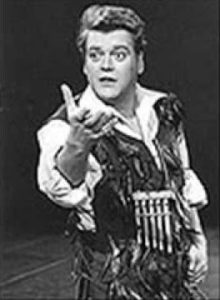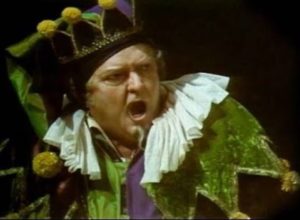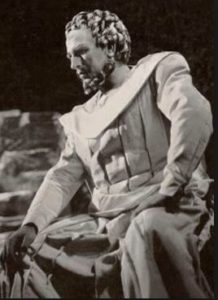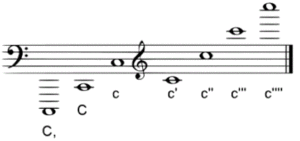Singers of the baritone Fach are divided into four categories with characters ranging from the light and agile friend and companion to kings and gods. The sheer versatility of the baritone voice makes the baritone a very busy man in any opera house. Follow the links to both sound examples and an extensive listing of typical roles and audition arias.
Part one: Spiel- und Charakterfächer: [ʃpi:l ʊnt ka.’ʁak.tɐ.fɛ:.çɐ]
LYISCHER (HOHER) BARITON/SPIELBARITON [‘ly:.ʁɪ.ʃɐ ‘ho:.ɐ ‘ba:.ʁi.tɔn ‘ʃpi:l.ba:.ʁi.tɔn] (B to g’)

The Lyischerbariton is an extremely important singer in the German opera house as he sings many supporting roles of diverse character leaving the meaty roles to the more dramatic baritone voice. The voice is a supple, flexible instrument with a mellow line an extended top. It is not necessary to have a high A flat to sing this Fach but a solid high G is a must. This baritone must be a good actor with great facility in all languages and able to sing equally well in all registers of his voice. Typical Lyrisherbariton / Spielbariton roles include Papageno in Die Zauberflöte, Figaro in Il barbiere di Siviglia, Malatesta in Don Pasquale, Harlekin in Ariadne auf Naxos, Silvio in Pagliacci, and Dandini in La cenerentola.
Singers: Herman Prey, Gino Quilico, Gino Bechi
Example: in Ariadne auf Naxos
CHARAKTERBARITON [ka.’ʁak.tɐ.’ba:.ʁɪ.tɔn] (A to g#’)
A powerful Zwischenfach voice capable of fine nuance and characterization.
This Fach includes the roles generally associated with the Verdi and Puccini repertoire. This baritone must be a “heavy” on stage and possess a powerful sound, commanding appearance, and have a ringing high voice. The main roles for Charakterbariton include the standard Verdi roles such as the title role in Rigoletto, Iago in Otello, and the heavier Puccini roles of Scarpia in Tosca, Marcel in Il tabarro, and the title role in Gianni Schicchi. His German repertoire includes the Musiklehrer in Ariadne auf Naxos, the four villains in Hoffmanns Erzählungen, Alberich in Wagner’s Ring, and Klingsor in Parsifal.

Singers: Leonard Warren, Sherill Milnes, Antonio Scotti, Ettore Bastianini, Tito Gobbi, Renato Bruson, Piero Cappuccilli, Matteo Manuguerra, Leo Nucci, Paolo Coni, Giorgio Zancanaro, Roberto Frontale, Geraint Evans, Lawrence Tibbett, Robert Merrill, Cornell MacNeil, Louis Quilico
Examples: Leonard Warren, Rigoletto; Sherill Milnes, Les contes d’Hoffmann
Part two: Seriöser Fächer [ze.ʁi.’ø:.zɐ ‘fɛ:.çɐ]
KAVALIERBARITON [ka.va.’li:.ɐ.’ba:.ʁi.tɔn] (A to g#’)

The Kavalierbariton has a somewhat heavier voice than the Spielbariton and plays a more important role on the stage. He must be attractive enough to play Mandryka in Arabella, the title role in Eugen Onegin, and the Don in Don Giovanni. Unlike the Lyrischerbariton, he has a noble, baritonal quality with a metallic edge that allows him to sing both lyric and dramatic phrases with ease. He must also have the vocal beauty to sing the Rodrigo in Don Carlo and father Germont in La traviata. Furthermore, he is generally entrusted with the role of the Count in both Le nozze di Figaro and Der Wildschütz.
Singers: Eberhard Wächter, Thomas Hampson, Sergei Leiferkus, Dmitri Hvorostovsky, Vladimir Chernov, Jorma Hynninen, Thomas Allen, Hakan Hagegard
Example: Thomas Hampson and Eberhard Wächter, Le nozze di Figaro
HELDENBARITON (previously called HOHERBASS) [‘hɛl.dən.ba:.ʁi.tɔn ‘ho:.ɐ.bas] (G to f#’)
A heavy, projecting instrument, that not only has a soaring top, but also a smooth, carrying middle and low register.

This Fach is a child of the German opera and is primarily reserved for the exceptionally heavy Verdi roles, such as Amonasro in Aïda and the Wagner roles including Kurvenal in Tristan, Telramund in Lohengrin, and Wotan. The voice must be big and have the ability to sound cruel, and yet have tremendous expansive ability. It helps to be a large person in this Fach but it is not absolutely necessary.
Singers: George London, Rudolf Bockelmann, Friedrich Schorr, Hans Hotter, Thomas Stewart, Donald McIntyre, James Morris
Examples: Hans Hotter and George London, Die Walküre
____________________
Helmholz notation

(This article is the seventh part in the series on the German Fach System and is based on information derived from Rudolf Kloiber’s “Handbuch der Oper”, 9th edition, Deutschen Taschenbuch Verlag. Read the first part of this series here.)
